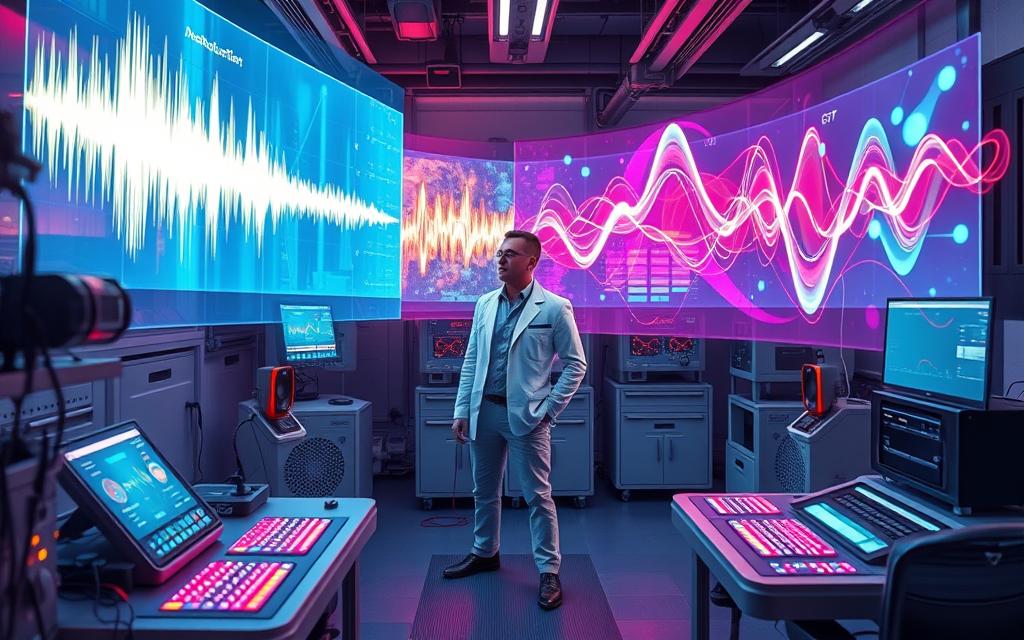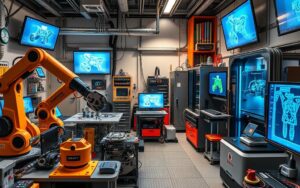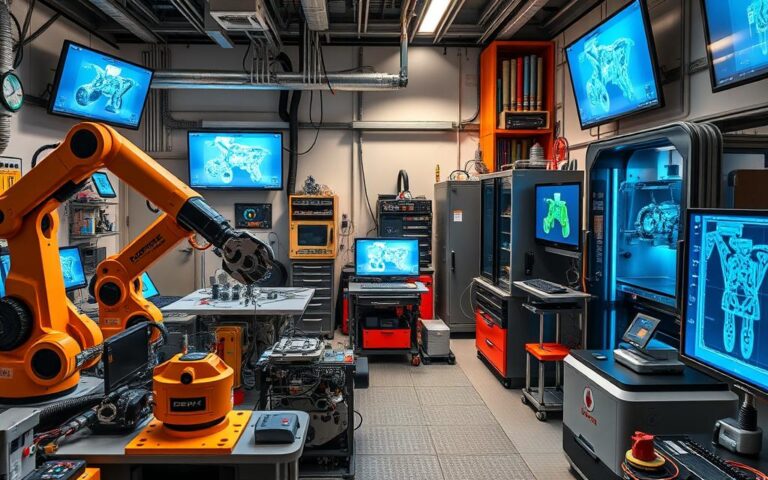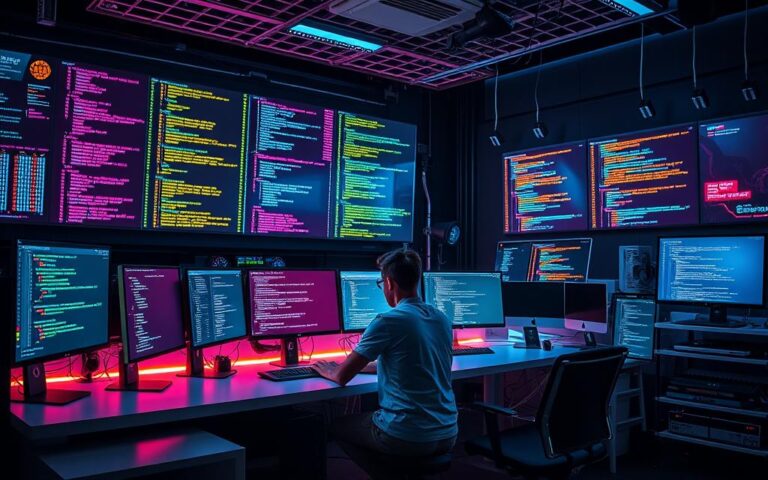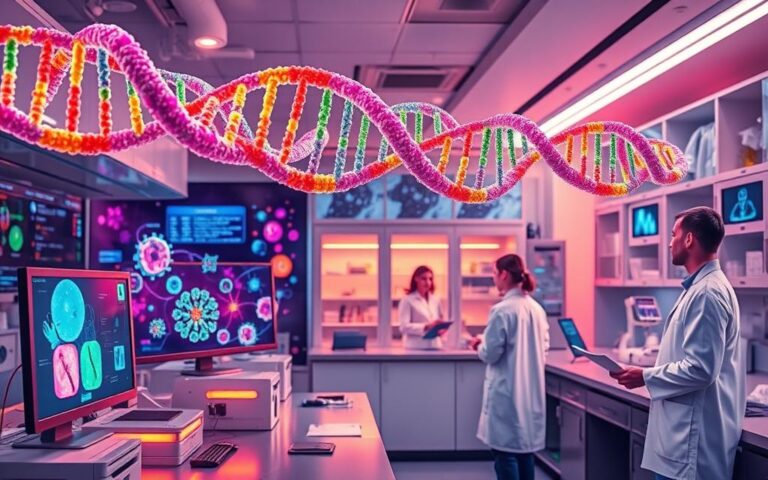What Is De-Mixing Technology?
De-mixing technology is a big step forward in audio engineering. It lets sound engineers isolate specific parts of an audio mix. This process is key for tweaking certain sounds in a recording. It makes the music we hear richer.
The use of de-mixing technology has grown a lot recently. An example of its use is in Peter Jackson’s documentary. This shows how it works like taking apart a cake to get each ingredient. It can separate voices, instruments, and other sounds. This changes the way we separate sounds and sets new standards in music production.
An Overview of De-Mixing Technology
De-mixing technology is a key part of today’s audio engineering. It defines a process that improves sound quality. By isolating and adjusting elements in music, professionals can tweak vocals, instruments, and effects creatively. Thanks to the growth of audio tech, we now have better ways to make and fix music.
Defining De-Mixing Technology
De-mixing splits recordings into separate parts using high-tech methods. It often uses artificial intelligence to do this. This tech is great for remixing famous albums or fixing old tracks. It lets engineers mix sounds with more impact and better quality.
- Separation of elements like drums, bass, and guitar from original recordings.
- Utilisation of AI to clean and refine audio tracks.
- Creation of clearer and more distinct sounds through advanced algorithms.
Historical Context and Evolution of De-Mixing
The story of de-mixing starts at Abbey Road Studios, where the ideas first came about in the early 2000s. A standout project was The Beatles’ “Revolver” from 1966. It shows how hard it was to pull apart sounds from a simple four-track tape. This spirit of innovation marks the journey of de-mixing and how it’s changed with new tech.
Here are some key moments in its history:
| Year | Event | Details |
|---|---|---|
| 2009 | Techniques Developed | James Clarke starts working on de-mixing at Abbey Road Studios. |
| 2011 | Project Release | “Live At The Hollywood Bowl” by The Beatles uses de-mixing. |
| 2021 | Get Back Project | New look at The Beatles’ history with advanced de-mixing. |
As the tech gets better, we can only expect more improvements in sound through de-mixing. This means even more exciting chances for making music.
The Science Behind De-Mixing Technology
The de-mixing technology depends on audio algorithms and digital audio processing. These algorithms help isolate sounds. This means users can pick out instruments from a mix. This technology analyses audio closely, recognising and improving specific sound patterns.
How Algorithms Enhance Audio Separation
De-mixing uses complex audio algorithms to identify instruments. They look at the mix’s frequency spectrum to pull out vocals, guitars, and drums. This helps adjust sound levels and gives producers more control over their music.
The Role of Spectrogram Models
Spectrogram models are crucial in de-mixing. They show the frequencies of sounds in an easy-to-understand way. This helps identify instruments in a mix. With these models, engineers can fine-tune audio within a track.
Understanding Masks in the De-Mixing Process
Audio masks work like filters in de-mixing. They let some sounds through while blocking others. This helps sound engineers get a clearer mix. They can adjust each part of the mix separately, making everything sound clearer.
| Aspect | Description |
|---|---|
| Audio Algorithms | Complex computations to enhance audio separation. |
| Sound Isolation | Identifying and extracting specific sound elements. |
| Spectrogram Models | Visual representation of sound frequencies for better analysis. |
| Audio Masks | Selectively filters audio to retain desired elements. |
| De-Mixing Process | Methodology to separate audio components from a mix. |
| Sound Patterns | Recognisable frequency signatures for different instruments. |
Applications of De-Mixing Technology
De-mixing technology has changed the game in music making. It opens new doors for artists and sound engineers. They can now play with sounds in ways that were not possible before. This is great for new songs and for breathing new life into classic hits.
Creative Uses in Music Production
In music making, de-mixing has been a game-changer. It lets producers take apart and mix together different parts of a song with ease. Artists can now twist and turn songs into something entirely new. They can even create new versions of songs. Using de-mixing technology, they bring songs to life in surround sound, making the listening experience amazing. The way they place sounds of drums and vocals is key for clear sounds in the end.
Restoration of Vintage Audio Tracks
De-mixing also plays a big role in bringing old songs back to life. It’s important for keeping music history alive. Sound engineers can fix old recordings, making them sound fresh while keeping their original soul. They can remove unwanted noises, making the songs sound clearer. This way, old classics get a new lease of life for everyone to enjoy.
Insights from Abbey Road Studios
Abbey Road Studios is leading the way in using de-mixing technology. They are known for their top-quality sound work. They share how careful work with sound pieces, along with new tech, helps producers improve their music. The studio is great at enhancing music by arranging sounds in spaces. This shows using modern technology in music is crucial for making better sounds.
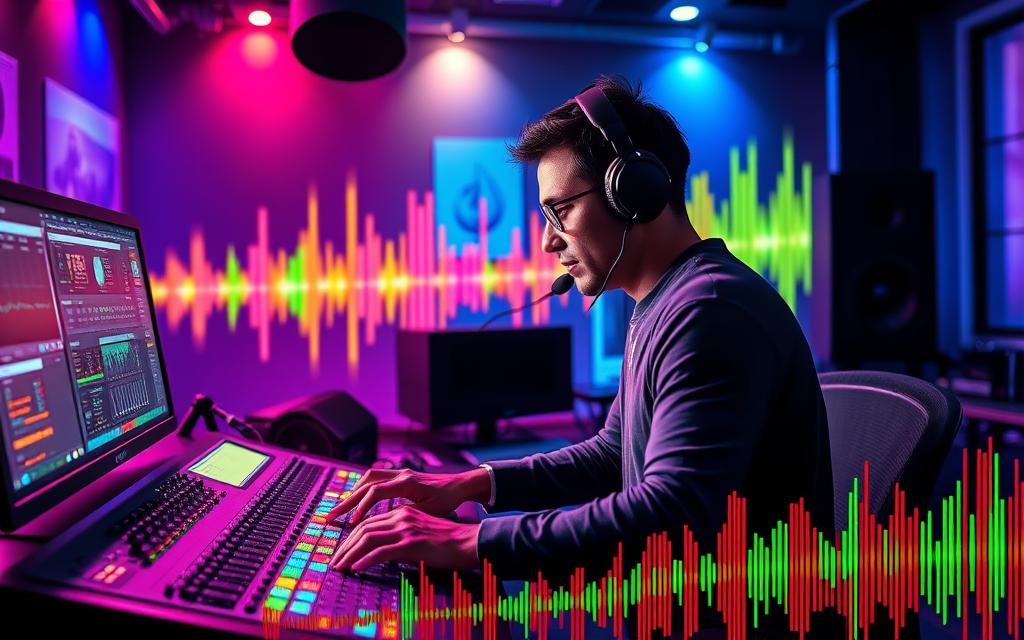
| Feature | Detail |
|---|---|
| Audio Formats | 5.1 and 7.1.4 Surround Sound |
| Usage of Software | Plogue Bidule for Up-Remixing |
| Analysis Method | Identification of Audio Anomalies |
| Creative Freedom | Vocal and Instrumental Distribution |
| Segregation Behavior | Dusty vs Non-Dusty Mixtures |
| Segregation Mechanisms | Percolation, Sifting |
| Parameters Influencing Segregation | Particle Size, Density, Elasticity |
| Installation Locations | Chutes, Transfer Points |
Benefits and Impact of De-Mixing Technology
De-mixing technology offers great benefits in the audio industry. It improves audio clarity and precision. By separating different audio elements, sound engineers can create exceptionally refined results. This technology has changed the way music and audio are produced. It makes recordings clearer than before.
Enhancing Audio Clarity and Precision
Better audio quality is crucial. De-mixing technology allows for detailed separation of sounds. This makes the audio clearer. Engineers can work with individual layers to enhance the listening experience. Each sound in the final mix is more distinct. This technology helps artists and producers achieve their creative goals.
Potential for Future Innovations
The future looks bright for audio technology. De-mixing technology will continue to get better. With machine learning and deep learning, audio separation will improve. These new methods could adjust audio in real-time, changing recording production. This evolution will make de-mixing technology essential for audio creators.
Conclusion
Exploring de-mixing technology shows us how audio engineering is changing. We see how it’s reshaping music production and restoring old recordings. It’s more than a passing trend—it’s changing how we handle sound.
As these algorithms get better, they bring big changes to the industry. Tools like the AdRess algorithm are creating new ways to work with sound. This makes music clearer and pushes us towards better technology.
This technology’s future will open up new creative paths. It lets artists and engineers try out new ideas. We’re looking forward to seeing where this will take us. It’s clear this technology will keep playing a big role in future sounds.
FAQ
What is de-mixing technology?
De-mixing technology is a cutting-edge method used to separate parts of audio tracks. It helps sound engineers enhance sections of recordings. This improves the sound quality.
How does de-mixing technology work?
It uses complex algorithms to pick apart different sounds, like vocals and instruments. This results in cleaner audio.
What are the origins of de-mixing technology?
It started at Abbey Road Studios, created by James Clarke in 2009. He led the way in developing these audio techniques.
How has de-mixing technology evolved?
It made its debut with The Beatles at The Hollywood Bowl in 2011. Since then, it’s improved tracks by stars like David Bowie and The Rolling Stones.
Why are algorithms important in de-mixing technology?
Algorithms are key for precise audio separation. They identify and extract specific sounds, improving production creativity.
What role do spectrogram models play in de-mixing?
Spectrogram models visually show sound frequencies. They help software detect different instruments for better audio parts separation.
What are masks in the de-mixing process?
Masks are like filters in de-mixing. They isolate wanted sounds from the mix, similar to how a sieve works.
How does de-mixing technology benefit music production?
It lets producers mix track elements with high accuracy. This opens up new ways to craft music.
Can de-mixing technology restore vintage audio tracks?
Yes, it’s great at making old songs sound clearer. This brings classic tracks to modern listeners while keeping the original vibe.
What insights can be gained from Abbey Road Studios regarding de-mixing?
Abbey Road Studios is central to de-mixing’s progress. They’ve set a benchmark for remixing and restoring music tracks.
What are the benefits of de-mixing technology for audio clarity?
De-mixing boosts sound clarity by focusing on individual elements. This creates sounds that are clean and appealing to the ear.
What does the future hold for de-mixing technology?
The future is bright with advancements in deep learning. These may further refine audio production, offering new adaptive features.
